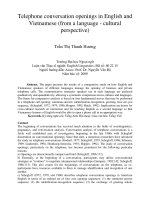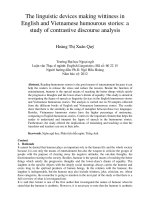Conditional Clauses Used as Hedging Devices in English and Vietnamese Equivalents a Pragmatic Perspective
Bạn đang xem bản rút gọn của tài liệu. Xem và tải ngay bản đầy đủ của tài liệu tại đây (147.27 KB, 6 trang )
Conditional Clauses Used as Hedging Devices
in English and Vietnamese Equivalents: a
Pragmatic Perspective
Mệnh đề điều kiện được sử dụng làm phương
tiện rào đón trong tiếng Anh và tương đương
của chúng trong tiếng Việt: nghiên cứu trên
bình diện dụng học
Ngô Thị Minh Trang
University of Languages and International Studies
M.A. Thesis. English Linguistics; Mã số: 60 22 15
Supervisor : Dr. Ngô Hữu Hoàng
Năm bảo vệ: 2012
Abstract. Numerous studies have been carried out to investigate English conditionals
in light of syntactics and semantics; however, limited research has been done to
evaluate the pragmatic functions of conditionals, particularly in Vietnamese context.
This study, therefore, is done with an aim to offer a detailed analysis of conditionals in
light of pragmatics. The study employed a qualitative approach through data collection
and analysis from a well-known novella. The data then were quantitatively converted
into numeric patterns as the primary basis for organizing and reporting results. The
findings of the study show that conditional clauses are not only used in English for
referring to real as well as hypothetical conditions and their consequences but can be
also used as a hedging device to issue politeness, especially in spoken contexts, where
the if-clause often stands alone and is independent of the main clause. Hopefully, this
study would offer both theoretical & practical contribution on the area of pragmatic
studies particularly on analyzing conditionals used in language basing on the
Cooperative Principle and Politeness Theory. Theoretically, this study is hoped to
broaden the understanding of pragmatic functions of conditional in real
communication. It is also expected that the findings in this study will give a direct
contribution to the existing knowledge in the field of pragmatic studies. Practically,
the researcher hopes that this study can provide the educators with the appropriate
explanations of pseudo-conditionals such as “If you like…, If I may interrupt…” to
their students. Additionally, this study could offer learners some ways to express
politeness in communication by using pseudo-conditionals. Likewise, this research is
expected to give the foundation and an important direction for those who are interested
in translating English conditionals into Vietnamese ones.
Keywords. Tiếng Anh; Tiếng Việt; Mệnh đề điều kiện; Giao tiếp
Content.
The thesis is divided into three parts as follows:
The first part is the Introduction, which presents the basic information such as:
rationale for the study, objectives of the study, scope of the study, research questions,
methods, as well as design of the thesis.
The second part is the Development of the study, divided into three chapters:
- Chapter 1 provides relevant theoretical background to this study.
- Chapter 2 examines the pragmatic relation of If - hedging with Cooperative
Principle and Politeness Principle in English and Vietnamese.
- Chapter 3 presents an analysis of the data as well as the interpretation of the
results in order to attain the objectives of the study.
The last part is the Conclusions which summarize what is addressed in the study,
points out the limitations and provides some suggestions for further study.
References.
Vietnamese:
1. Nguyễn Tấn Đại, (2001), Hoàng Tử Bé (Trans.), Nhà xuất bản Hội Nhà Văn,
TP. HCM
2. Lê Thị Minh Hằng, (2009), Câu Điều Kiện Tiếng Việt dưới góc độ ngữ dụng,
Retrieved from the website:
English:
1. Akatsuka N. (1986), Conditionals are discourse bound, Cambridge University
Press.
2. Austin J. L. (1962), How to do Things with Words, Oxford, Oxford University
Press.
3. Bonano M. (1982), Women’s language in the medical interview, Linguistics
and the Professions, Norwood, N.J: Ablex.
4. Brown P., Levinson S. C. (1987), Politeness: Some Universals in Language
Use, Cambridge, Cambridge University Press.
5. Buikema R., Roeters A. (1982), Politeness Strategies in the Interaction of
Women and men, Mexico City.
6. Coates J. (1989), Women’s Speech, Women Strength? York Papers in
Linguistics 13.
7. Cobuild C. (1990), English Grammar, Collins Birmingham University
International Language Database.
8. Coulmas F. (1981), Conversational Routine, The Hague, Netherlands, Mouton.
9. Crompton P. (1997), Hedging in Academic Writing: Some Theoretical
Problems. English for Specific Purposes.
10. Crystal D. (2008), A Dictionary of Linguistics and Phonetics, Malden, MA:
Blackwell Pub.
11. Drechsel J. (1989), Peer Groups and the Language of Negotiation in Education
Linguistics.
12. Elbaum S.N. (1986), Grammar in Contex, Boston, Cengage Heinle.
13. Fasold R. W., Shuy R. W. (1977), Studies in language variation: semantics,
syntax, phonology, pragmatics, social situations, ethnographic approaches,
Georgetown University Press.
14. Fraser B. (1975), Hedged Performatives, Syntax and Semantic volume 3: Speech
acts, New York.
15. Fraser B. (1996), Pragmatic Markers, Boston University.
16. Fraser B. (2010), Pragmatic Competence: The Case of Hedging, Emerald
Group Publishing Limited.
17. Fraser B., Nolen, W. (1981), The Association of Deference with Linguistic
Form, International Journal of the Sociology of Language.
18. Gabrielatos C. (2003), Conditional Sentences: ELT typology and corpus
evidence, Paper given at the Annual Meeting of the British Association for
Applied Linguistics, University of Leeds.
19. Grice H. P. (1975), Logic and Conversation, Syntax and Semantics 3: Speech
Acts, New York, Academic Press.
20. Groenendijk J., Stockhof M. (1984), Studies in the semantics of questions and
the pragmatics of answers, Doctoral Dissertation, University of Amsterdam.
21. Haiman J. (1978), Conditionals are Topics, Language 54.
22. Halliday M. A.K., Hasan R. (1989), Language, Context and Text: a social
semiotic perspective, Oxford.
23. Hatch E. (1992), Discourse and Language Education, Cambridge, Cambridge
University Press.
24. Holmes J. (1982), Expressing doubt and certainty in English, RELC Journal.
25. Hyland K. (1994), Hedging in Academic Writing and EAP textbooks. English
for Specific Purposes, Vol. 13.
26. Hyland K. (1998), Hedging in Scientific Research Articles, Amsterdam, John
Benjamins Publishing Company.
27. Kitamura N. (2000), Adapting Brown and Levinson‟s „Politeness‟ Theory to the
Analysis of Casual Conversation, Australia.
28. Lakoff G. (1972), Hedges: a study in Meaning Criteria and the Logic of Fuzzy
Concepts in Papers from the Eight Regional Meeting, Chicago, Chicago
Linguistic Society.
29. Lyons J. (1977), Semantics, Cambridge, Cambridge University Press.
30. Markkanen R., Schröder H. (1989), Hedging as a Translation Problem in
Scientific Texts, Special Language: from Humans Thinking to Thinking
Machines, Clevedon, Multilingual matters.
31. Mauranen A. (2004), “They're a little but different” : Observations on hedges
in academic talk, Discourse Patterns in Spoken and Written Corpora,
Amsterdam/Philadelphia, John Benjamins Publishing Company.
32. Murphy R. (1996), English Grammar in Use, (Bilingual series), NXB Da Nang.
33. Myers G. (1989), The Pragmatics of Politeness in Scientific Articles, Applied
Linguistics.
34. Pyle M. A, Munoz M. E. (1994), TOEFL preparation guide, New York, John
Wiley & Sons.
35. Quirk R. (1987), A University Grammar of English, England, Longman Group
UK Limited.
36. Richards J. C., Schmidt R. (2010), Longman dictionary of language teaching
and applied linguistics (4
th
ed.), London, Longman (Pearson Education).
37. Riekkinen N. (2009), “This is not criticism, but…” Softening criticism: The use
of lexical hedges in academic spoken interaction, Unpublished MA thesis,
University of Helsinki.
38. Salager-Meyer F. (1994), Hedges and Textual Communicative Function in
Medical English Written Discourse, English for Specific Purposes, Vol 13.
39. Schmidt C. (1974), The Relevance to Semantic Theory of a Study of Vagueness
in Papers from the Eight Regional Meeting, Chicago, Chicago Linguistic
Society.
40. Searle J. R. (1969), Speech Acts: An Essay In The Philosophy of Language,
Cambridge, Cambridge University Press.
41. Skelton J. (1988b), Comments in academic articles, Applied Linguistics in
Society, London, CILT/BAAL.
42. Thomson A. J, Martinet A. V. (1986), A Practical English Grammar, Oxford,
Oxford University Press.
43. Verschueren J. (2000), Understanding Pragmatics, Beijing, Foreign Language
Teaching and Research Press.
44. Weinreich U. (1966), On the semantic structure of English, Universals of
language, Cambridge, MA: MIT Press.
45. Wilamová S. (2005), On The Function of Hedging Devices in Negatively Polite
Discourse, Brněnské University.
46. Wilamová S. (2005), On Expressing Negative Politeness in English Fictional
Discourse, Ostrava, Ostravská University.
47. Woods K. (1971), The Little Prince (Trans.), Mariner Books.









